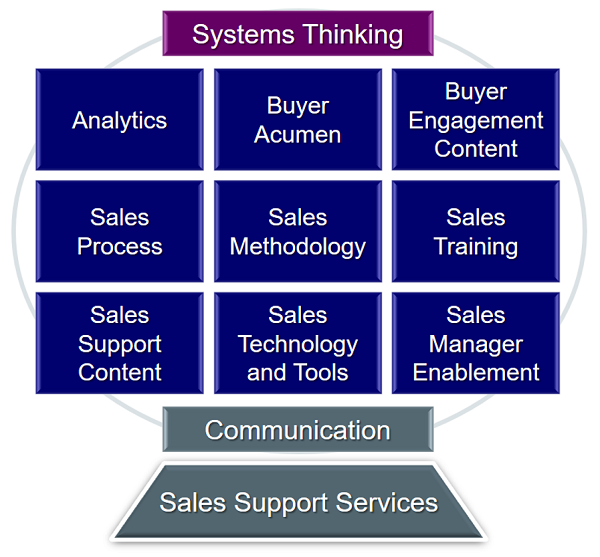ATD Blog
The “New Math” of Sales Enablement
Tue Sep 11 2018

Bookmark
If you have children or know someone who does, you’ve likely run across the “new math.”
I can’t speak to how well the new math is working in our public education system (it appears the jury is still out), but I do believe we need our own “new math” in the sales enablement profession—one that we know will work and get the results our sales leaders, executives, shareholders or stakeholders, and especially our customers expect from our sales forces.
Building Blocks + Systems Thinking + Performance Consulting
= (Elevate Profession) x (Drive Revenue Growth)2
I can almost hear you now: “Uh, what??” I know, I know—this is the new math part. But it’s actually very simple, when you dig in. Let’s do that.
The Building Blocks of Sales Enablement
These building blocks are the foundation for any top-performing sales enablement function. Not every department can do everything here, right out of the gate. My first recommendation is to craft a charter and gain alignment around the expectations with all stakeholders. Then you can continue over time to implement all aspects of the building blocks as you evolve toward a true performance consulting function.

Here is an overview of the building blocks:
Analytics
Benchmark your sales metrics, including conversion ratios, deal size, cross-sell, ramp-up times for onboarding, pipeline velocity, content sharing, KPIs—whatever is important for your business. Track results pre- and post-training. Also track your sales onboarding and learning metrics. Analyze everything.
Buyer Acumen
Identify your buyer personas. What problems are they trying to solve, what outcomes are they trying to achieve, what are the metrics that matter most to each?
Document your buyer’s journey, including buying process exit criteria or decision process and decision criteria.
Buyer Engagement Content
Align your marketing content (and lead-gen campaigns), sales content/collateral, and sales messaging to identify the problems, and address the buying process exit criteria.
Sales Process
Align your sales process to the buyer’s journey. Document tasks and exit criteria for both your buyers and your sellers.
Sales Methodology
Select appropriate sales methodologies for prospecting, opportunity management, and strategic account management/development. Develop sales competencies by role from a top-producer analysis, whenever possible, or proven best practices. Customize.
Sales Training
Build sales onboarding/training that supports the above. Develop ongoing training based on sales competency gaps and new offerings. Train managers first, then reps. Establish a system to support learning, skill development, and behavior change: train, sustain knowledge, develop skills, transfer skills, and coach to mastery.
Sales Support Content
Develop sales support, including job aids, checklists, training reminders, calculators and other tools to support your sales process and methodology.
Sales Technology and Tools
Select and implement sales technology to support your sales force, create efficiency, and increase time spent selling.
Sales Manager Enablement
Select an appropriate sales coaching model. Train managers on coaching. Foster a coaching culture.
Determine your management operating rhythm and management disciplines you want to instill. Train managers on that and hold them accountable for executing.
Systems Thinking
Implement a Sales Support System, supported by a Sales Learning System, to perpetuate the above and pull everything together.
Communication
Manage communication to the sales team. Become the single point of contact and communication, delivering important organizational communication to the sales force in consistent ways.
Sales Support Services
Not all departments can offer these. It’s entirely based on budget, resources, sales force needs, and leadership expectations. Here are some sales support services to consider, which some sales enablement teams do provide to their sales forces:
assisting with buyer- and customer-facing presentations (creation/customization)
conducting account or contact research/prospecting preparation
offering preparation services for meetings
providing RFP support
offering Deal Desk services
delivering coaching services (I prefer this to support managers, more so than direct sales rep coaching).
Hopefully that gives you some ideas to consider. In some organizations, a few of these services are often coordinated by sales operations. Sales enablement teams often collaborate cross-functionally, and you can work out who does what in your charter.
Beyond the building blocks foundation, the next part of our formula is systems thinking. We’ll tackle that in our next post.
If you’d like to learn more, Mike is a speaker at ATD SELL 2018, where he will be presenting on his Sales Learning System with the Five Stages of Sales Mastery and Behavior Change on day 1 and leading a two-hour workshop on the topics in this post on day 2. Learn more about ATD SELL at https://events.td.org/Sell/About.
More from ATD

